Springtime in Arcadia: What to See, Do and...
Just a short distance from Athens,...
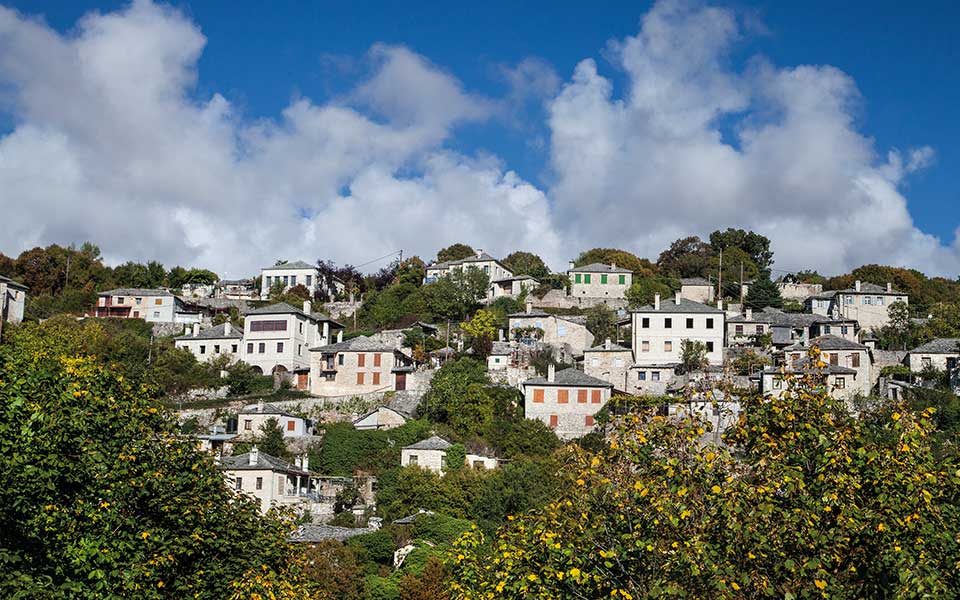
View of Vitsa with its characteristic stone houses and slate roofs.
© Olga Charami
“Will you sing me your carols?” It is the third time I ask, and nobody heeds my call. “Oh with you I want to be, and in Vitsa it will be fine,” young Kiki Harisi eventually sings, a member of the active Vitsa Cultural Society. Yet it is not a carol, but lines from the “Xehorismata,” a song that signals the end of the panigyri (traditional festival) on August 15th, which, in the depths of winter, seems rather out of place now.
Of course, everyone in Vitsa is already thinking about the panigyri; they look forward to it all year and are anxiously waiting for it to be included in the list of UNESCO sites of intangible cultural heritage: it is particularly special in that it lasts for three days. The first two are dedicated to the visitors, and the last day to the locals, so they are the only ones who have the right to lead the dance. Everyone in Vitsa participates and helps run the festival, no exceptions.
Yet it is not only this festival that Vitsa stands out for. It is perfectly located, in central Zagori, to be an ideal base for your explorations of the area. This is why the Vikos-Aioos Geopark Information Center will be opening here soon, in the heart of the Northern Pindos National Park. Boasting lovely hospitality and restaurants, it preserves a more genuine profile compared to nearby Monodendri, which is constantly overrun by tourist buses.
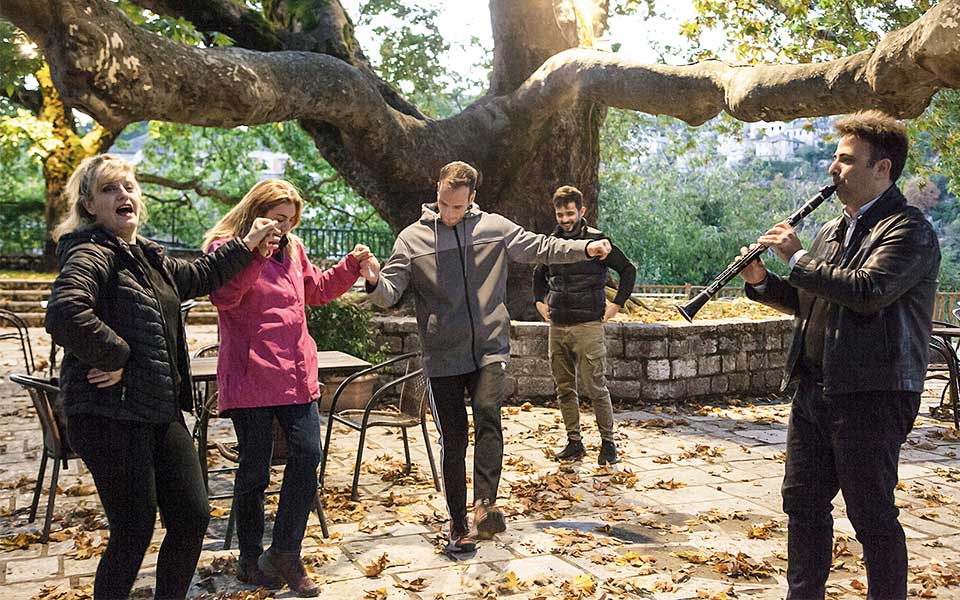
Clarinet music and dancing in Vitsa square, and not a festival in sight!
© Olga Charami
The characteristic Zagorian architecture of the famed 18th and 19th century artisans is clearly preserved in the neighborhoods of Vitsa (Mesohori, Ano and Kato Vitsa), featuring simple houses built solely from stone, yet expertly constructed using mortar made of mud and hay, timber framing and slate roofs.
The same applies to its churches that were constructed or renovated in the 16th and 17th century, and to the entire Zagori region – under the Ottoman occupation, Zagori was autonomous and self governed, thus becoming very wealthy due to its commercial activity. Churches such as Aghios Nikolaos, the Dormition of the Virgin and Taxiarchon Church – the only one you can visit, since it is open more often for services – are veritable artworks. The locals also consider the water cisterns as such, since they still were being used until the late 1980s, when there was no running water in the village.
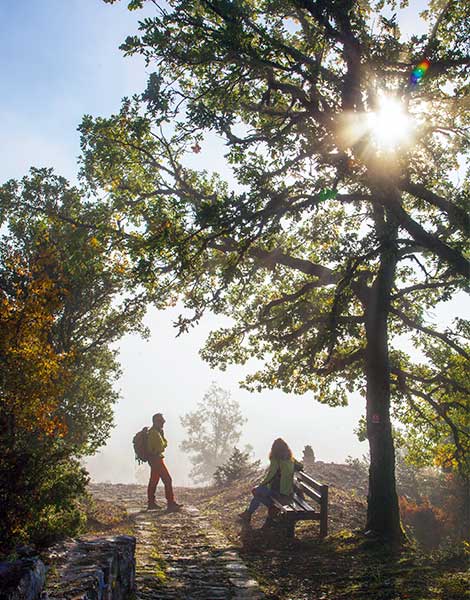
Hiking on the Vitsa Skala, in the morning fog.
© Olga Charami
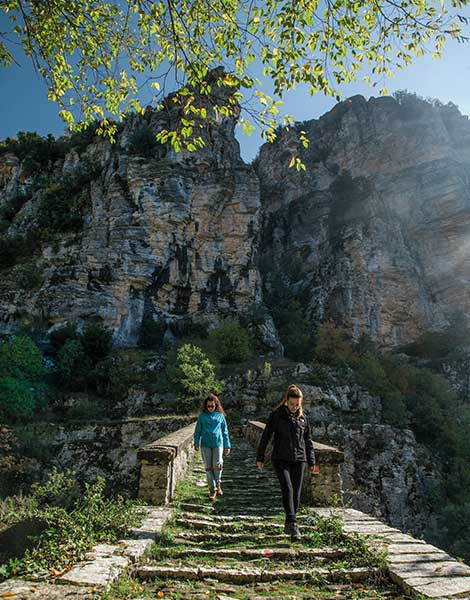
© Tasos Anestis
Vitsa is also famous for its Skala, the ornate narrow pathways that connected the villages in Zagori before the construction of a road network which, along with footbridges, used to be the only means of communication with the outside world. The width of the pathways were calculated so that the animals could take the turns with their cargo. The Skala of Vitsa, as well as the one in Vradettos, are the most impressive and were constructed in 1868. On winter mornings Skala is usually laced with fog, so if it snows, the snow melts away immediately.
The incline is exceptional but not at all tiring, while the descent to the Xeropotamos valley will not take more than 30 minutes. Traversing the dense forest makes you feel like a character in Tolkein’s Middle Earth, and culminates at the double arched Bridge of Misios, dating from 1748; one more masterpiece of Zagorian architecture.
From there you can continue walking to Koukouli or to Kokkori Bridge (also called the Footpath of Coexistence). This and other more challenging hikes can be arranged with Tasos Anestis as your mountain guide (tel. (+30) 6945.519.851). As an expert of the local natural environment, history and folklore, he organizes very interesting route-tours that also include lovely visits to villages, sites and select cafes/restaurants.
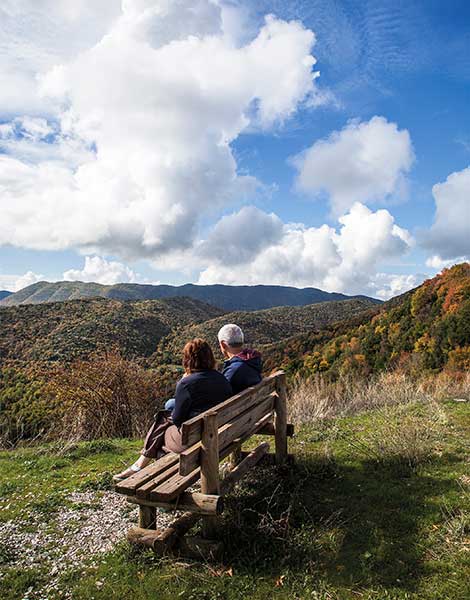
Gazing at the mountains of Tymfi.
© Olga Charami
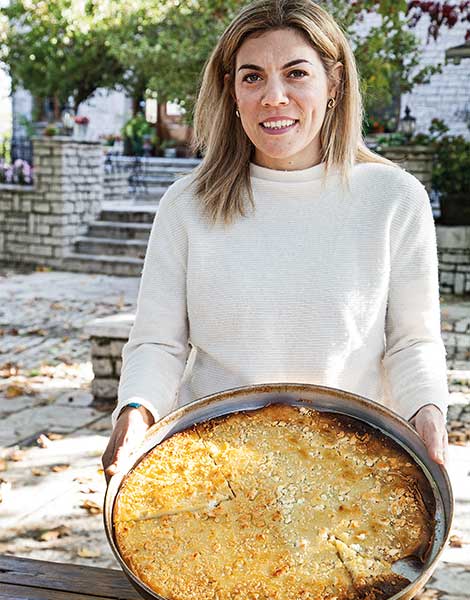
Maria Vasdeki organizes cooking workshops, where she teaches the art of making Zagorian pies.
© Olga Charami
In Vitsa, you can also participate in cooking lessons specialized in traditional pies from Zagori by Maria Vasdeki of the En Hora Vezitsa restaurant, or you can visit the Epekeina Hora multispace (epekeinahora.gr). Various events are organized in this renovated Zagorian venue: from musical performances and creative writing seminars to yoga lessons and presentations to raise environmental awareness.
Of course, you can just take a seat in the lovely square under the plane tree and catch up with the locals. One evening we sat there, sipping on local tsipouro. Alexis Liokatis, member of the musical troupe “Ipirotiko takimi” was also with us. And as he talked to us about musical tunes from Zagori and Pogoni, the legend of Epirote music Grigoris Kapsalis, and the traditional festival of the panigyri, we suddenly heard the sound of a clarinet.
That was all it took. In a matter of seconds, everyone was up and dancing. A handful of people, in the middle of the winter, in an empty square covered with plane tree leaves …
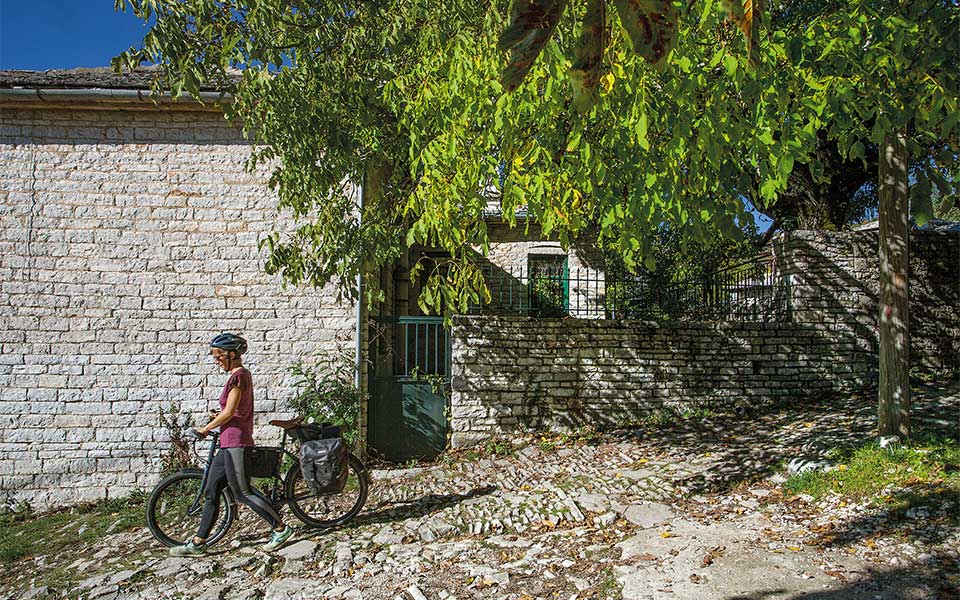
Exploring the narrow streets of Monodenri with a bicycle.
© Olga Charami
The most popular village of the area and one of the first to attract tourists due to its position as the start or the finishing point of the route traversing the Vikos Gorge, but also because of Kikitsa’s alevropites (thin batter feta pies), the old lady who offered food to the first hikers in the 1960’s.
The monastery of Agia Paraskevi, built in the 15th century and floating above the Vikos Gorge, remains an important attraction here in Monodendri to this day. Enjoy a coffee under the plane trees in the main square, purchase fine honey, propolis and other delights from the brand new Melistrati store (tel. (+30) 6947.602.935), and visit one of the spaces of the Rizarios Foundation (rizarios.eu): either the Rizarios Handicraft School where the skills of textile making, embroidery, carpet manufacturing, and sewing are taught; the exhibition space featuring handicrafts made by students; or the exhibition center of the Pantazis Mansion, where an exhibition of the great photographer Frédéric Boissonnas is hosted this year.
Monodendri is located 2.5 kilometers from Vitsa.
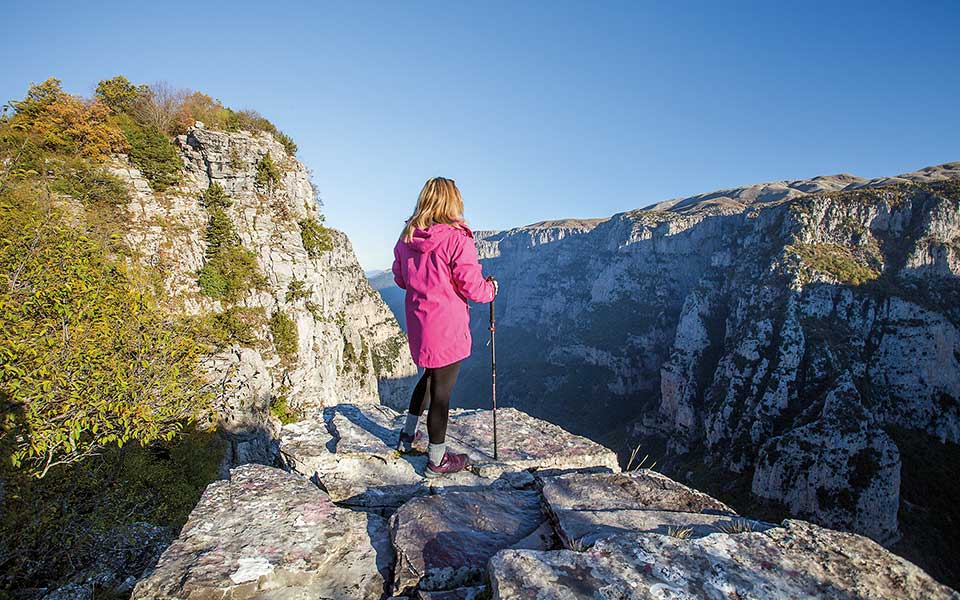
Enjoying the grandeur of the Vikos Gorge from the Oxia viewpoint.
© Olga Charami
People say that it is more beautiful to gaze over the Vikos gorge rather than to hike through it! Perhaps because the Oxia viewpoint, situated 7 kilometers after Monodendri, is one of the most beautiful points from where you can admire the deepest canyon in the world (deepest in proportion to its width, with a depth of 1250 meters at the narrowest width of 200 meters).
On the way you will also come across the so-called “stone forest,” bizarre rocks jutting out of the green forest landscape. These unusual limestone formations look like plaques stacked on top of eachother, an impressive and unique sight of natural beauty.
The Oxia viewpoint is located 10 kilometers from Vitsa.
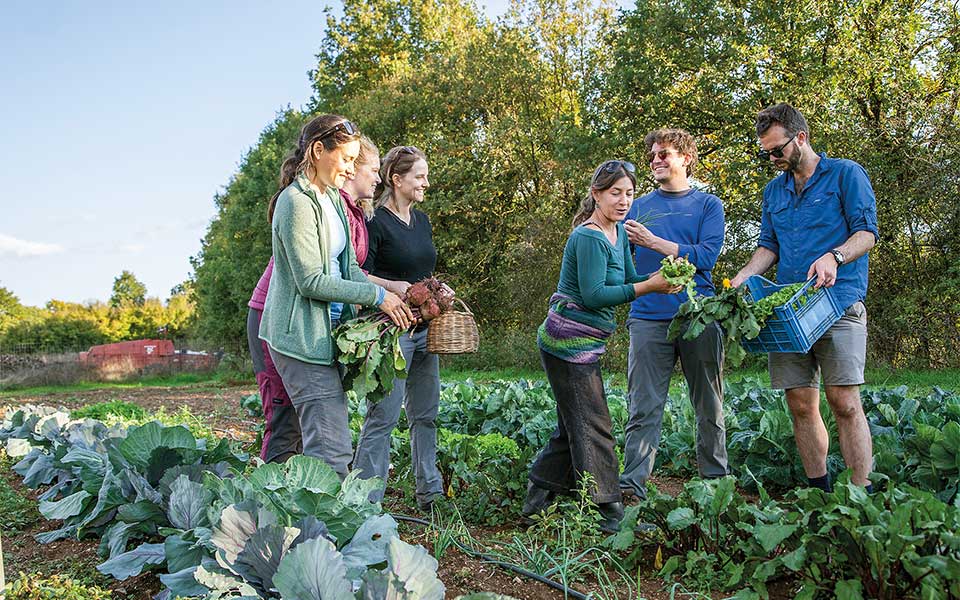
Collection of vegetables for the next meal at the Rokka agrotourism guesthouse.
© Olga Charami
Lena, Kostas and Lakis are three young people who gave Elafotopos a breath of fresh air by creating the Rokka guesthouse. It is worth meeting them and booking an appointment to participate in the agritourism events they organize. Lena, for example, will introduce you to the world of clay art and felting, as well as guiding you through the stages of wool processing – all the steps from shearing to yarn dyeing. You can also follow them to their lovely farm, help them take care of the animals and pick fruit or vegetables from the garden that you will then use to prepare your meal.
Ask them about the Pokari project that they participate in, an interesting initiative consisting of artisans, livestock farmers and scientists who aim at restoring the value of sheep wool of indigenous sheep breeds, connecting the primary sector with the ecology and the cultural heritage of the land (tel. 6942-485213, from 30 euros per person).
Elafotopos is located 10 kilometers from Vitsa.
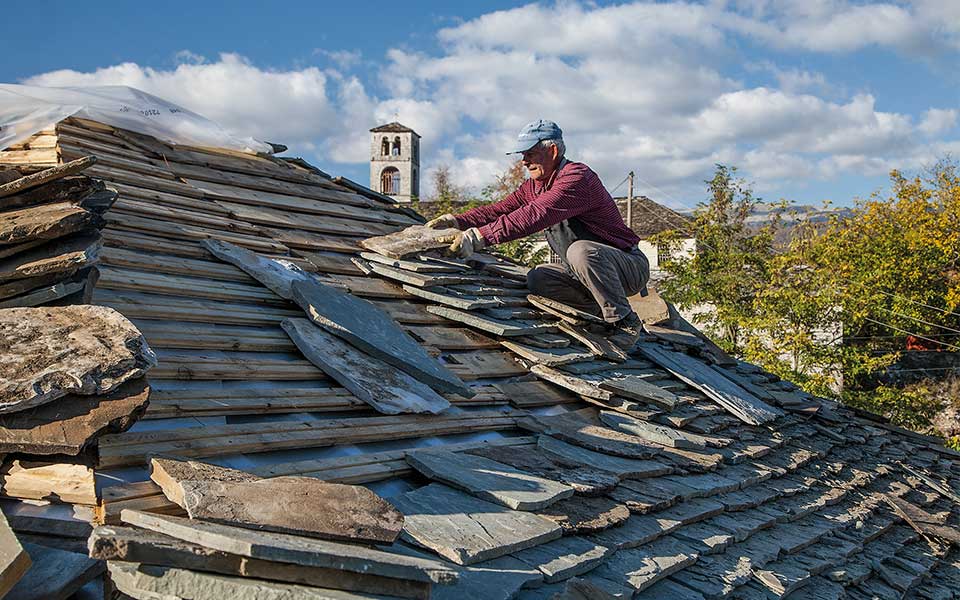
Constructing the famed Zagorian slate rooftops in Dilofo.
© Olga Charami
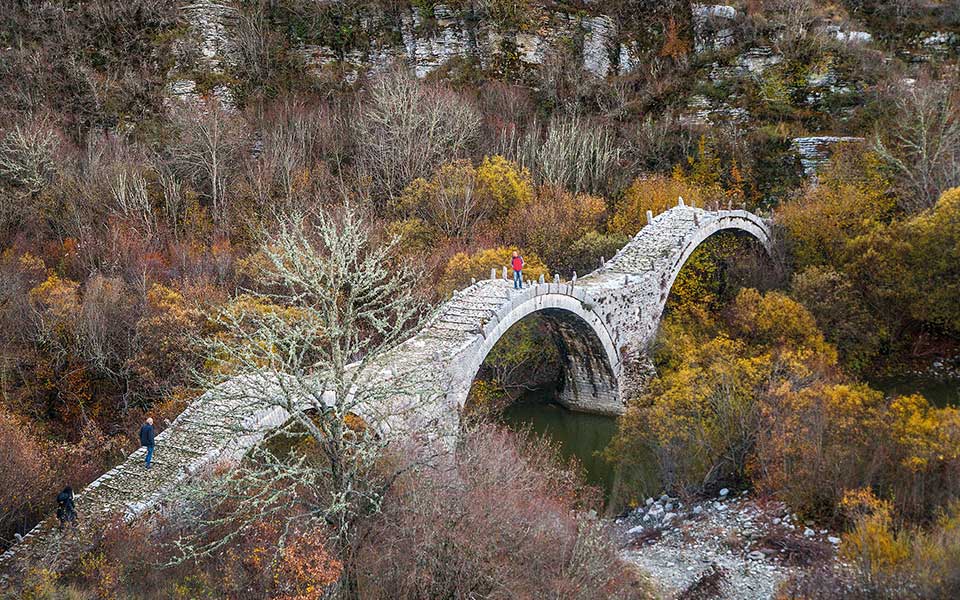
Perhaps the most special footbridge in Zagori, Kalogeriko Bridge or “caterpillar in motion,” outside Kipoi.
© Olga Charami
These two villages are examples of architectural beauty in their different ways. Dilofo with its few inhabitants is one of the most beautiful villages of Zagori and preserves its local architecture almost untouched. Walk to the Church of the Assumption of the Virgin Mary and take a look at the stone-built mansions – they say that the Makropoulos mansion at the entrance of the village is the highest in Zagori. At Kipoi you will come to admire the impressive footbridges, including some of the most famous in Epirus: the one-arched Kokkori Bridge (on the way to Koukouli) and the three-arched Plakida or Kalogeriko Bridge (also called the “caterpillar in motion” because of its graceful wave-like construction). Be sure to visit on your own or, even better, via an organized cycling trip with Trekking Hellas (tel. 6944-750009, trekking.gr).
Dilofo and Kipoi are located 11.5 and 15 kilometers from Vitsa.
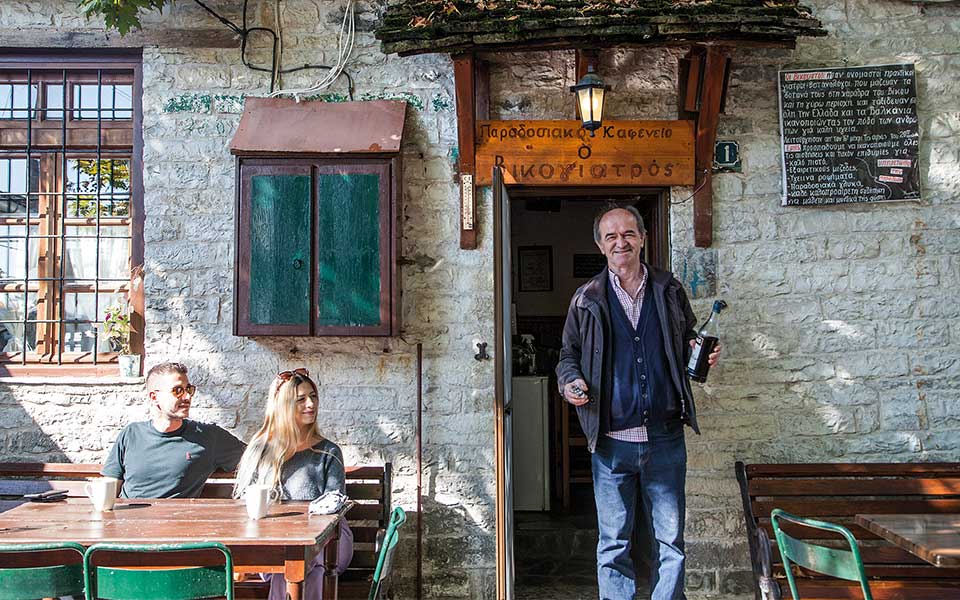
At Vikogiatros kafenion you will try the famed herbs of Vikos.
© Olga Charami
“My friend Nikitas Kapsalis brought me this plant. He found it in the valley of Dobra…” The handwritten notes by botanist Kostas Lazaridis are placed alongside every plant in the precious collection on display at the Botanical Museum in Koukouli (everyday, except Tuesdays, 09.00-15.00, tel. 26530-71775). Created by the Rizarios Foundation in his family home, the exhibits showcase the work of this prolific explorer who left a great collection of writings on the history, plants and folklore of Zagori.
After your visit, take a seat at Vikogiatros cafe: try a herbal tea or liqueur prepared with herbs from Vikos. Be sure to ask owner Nikos Kontodimos for an introduction to their therapeutic qualities.
Koukouli is located 15 kilometers from Vitsa.
TRANSPORTATION
Vitsa is 450 kilometers from Athens and 280 kilometers from Thessaloniki. Cost of tolls and fuel is estimated at 75 and 35 euros respectively, one way.
ACCOMMODATION
Zagori Suites (Vitsa, Tel. (+30) 26530.71076). The fireplace burns in the large chalet and you enjoy the calm from the comfortable sofas, as you gaze out at the surrounding mountains. The country decor, wood ceiling, dining room and fully-equipped kitchen compose the country house of your dreams, while the king size bed with its ecological mattress and feather down duvet guarantee the most restful sleep. In addition to the two chalets, there are also luxury suites and a large residence for families available, all fully-equipped. The breakfast is homemade and is accompanied by exceptional service and information on the area. Suites from 95 euros, with breakfast.
En Hora Vezitsa (Vitsa, Tel. (+30) 26530.71449).
Vezitsa used to be called Vitsa, and this connection with the past is also preserved in the guesthouse’s decor: rooms with built-in beds on either side of the fireplace, wood ceilings, low circular tables and kilims. The family also organizes additional cookery lessons and workshops, but also other outdoor activities in collaboration with local professionals. Double rooms from 65 euros, with breakfast.
Kores Boutique hotel & Spa (Vitsa, Tel. (+30) 26530.71888). A brand new offering with particularly tasteful rooms and suites, equipped with well-known linen brands and products, some featuring fireplaces. Facilities include a conference center, restaurant and wellness spa. Double rooms from 120 euros, with breakfast.
FOOD
The move of the restaurant Sta Riza (Tel. (+30) 26530.71550) to Vitsa from the village of Elati, where it operated for more than 15 years, is considered a triumph . How could it not, with its amazing views over the village and mountains, a beautiful dining area and a renovated menu that includes interesting creations such as mutton with gruyere cheese, Vetouli shank and the “snack,” featuring fresh fries, eggs and mincemeat.
The restaurant Kanela and Garyfallo (Tel. (+30) 26530.71671) is dedicated to mushrooms and good wine. In addition to a brand new wine cellar featuring many different wines from all over the country, you can also try a variety of soups, risotti, pasta or meat with mushrooms, either picked in the wild or produced by Vasili Katsoupas.
At En Hora Vezitsa (Tel. (+30) 26530.71449), in the wonderful square featuring an enormous plane tree, you may try delicious homemade dishes of the day, local pies and grilled meats. You will also eat well at Beloi restaurant (tel. 26530-71571) located in the hotel of the same name.
At Monodendri you should try I Pites tis Frosos (Tel. (+30) 26530.71320), while you should have a drink at Dipsasmeni Arkouda (Tel. (+30) 26530.71548), the only bar in the area that opened recently.
At Dilofo you will eat well at Lithos Restaurant, also known as “Taki’s” (Tel. (+30) 2653.-22600), and at Kipous sti Rodia (Tel. (+30) 26530.71695).
Just a short distance from Athens,...
With just 45 residents, Pityos is...
Discover five mountain destinations where crisp...
One of the most impressive canyons...